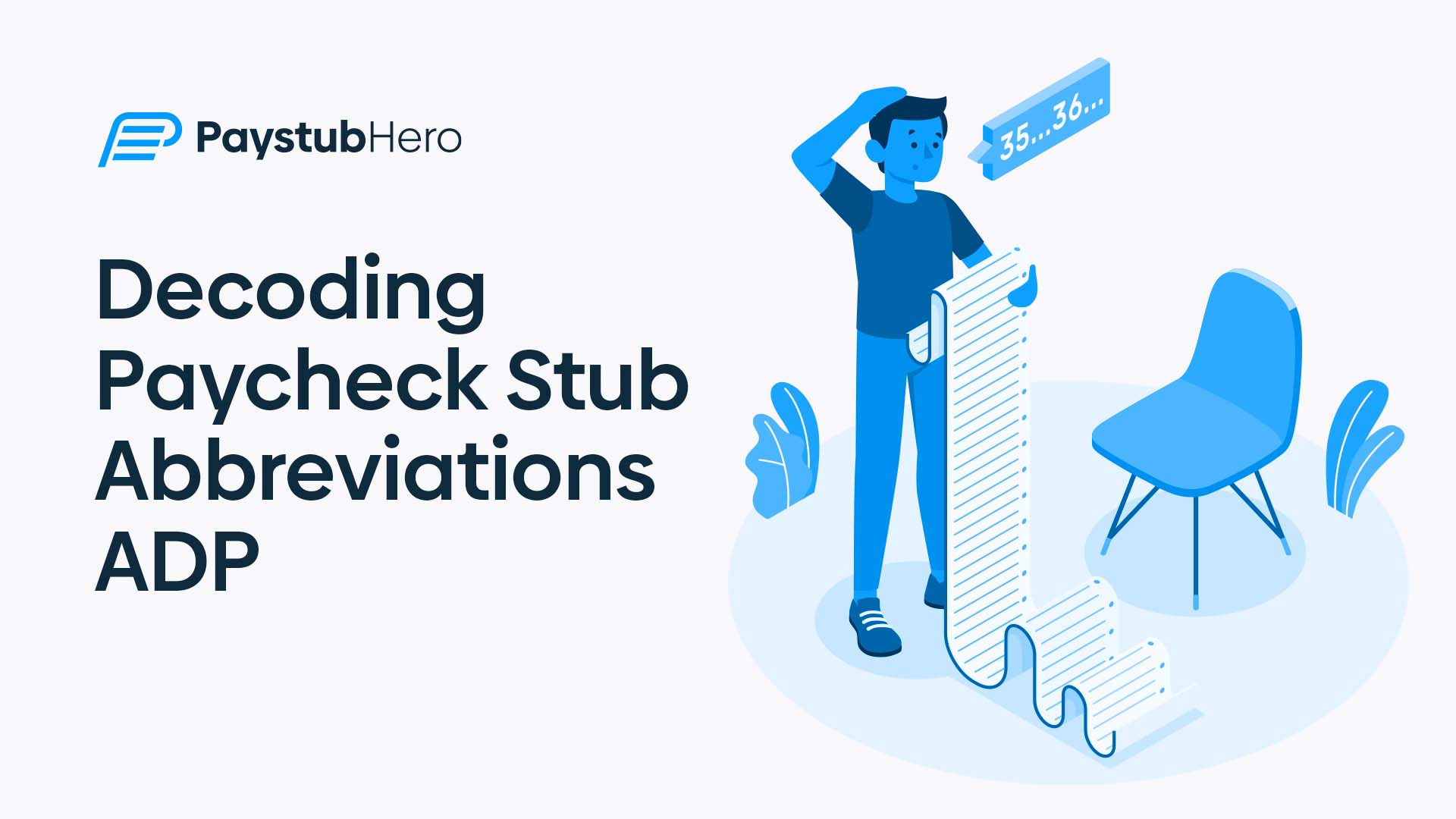If you’ve ever wondered about the paycheck stub abbreviations ADP, you’re in the right place. In the complex world of finance and payroll, one item stands between your earnings and your understanding of them: the paycheck stub.
Although it appears as a mundane piece of paper, it represents the hard work you’ve put in, the hours you’ve committed, and the contributions you’ve made to your company. Yet, for many, it remains a mystery.
It’s filled with lines, numbers, and abbreviations that look more like secret code than understandable information.
Every fortnight or month, you see these cryptic acronyms — FIT, SIT, FICA EE, and MISC — without truly understanding their implications. That is about to change.
The real barrier in understanding this financial document isn’t complexity; it’s clarity. The abbreviations and jargon used, particularly in ADP paystubs, can be confusing if you’re not a seasoned HR professional or accountant.
If you’ve ever asked yourself “what is FICA on my paycheck?” or wondered about the miscellaneous abbreviations on your ADP paystub, you’ve come to the right place.
Today, we’re setting out to demystify your paycheck stub. Our comprehensive guide will break down the most common “Paycheck stub abbreviations ADP” to help you understand the intricacies of your earnings, deductions, and overall income.
After all, understanding your pay is the first step towards financial independence.
Let’s start the journey of turning you from a paycheck novice into a paycheck guru. Are you ready? Let’s decode those abbreviations!
Table of Contents
- Introduction: Decoding Paycheck Stub Abbreviations: A Comprehensive Guide to ADP Terminology
- What Are ADP Paystub Abbreviations?: A Deep Dive Into Payroll Terminology
- Key Paycheck Abbreviations on an ADP Paystub: The Must-Knows of Your Earnings Statement
- What Is FICA On My Paycheck?: Understanding Your Contributions to Social Security and Medicare
- Decoding Miscellaneous Abbreviations: The Hidden Language of Your ADP Paystub
- Take Control of Your Paycheck With Knowledge: Empowering Financial Management Through Understanding
- Your Paystub, Simplified with PaystubHero: Seamless, Affordable, and User-Friendly Payroll Management
What Are ADP Paystub Abbreviations? A Deep Dive Into Payroll Terminology
You’re probably familiar with ADP, even if you don’t know it. This acronym stands for Automatic Data Processing, a leading name in the world of payroll, HR, and tax services.
With its roots going back to 1949, ADP today is one of the largest providers of business outsourcing solutions, boasting over 800,000 clients worldwide.
One of the key services offered by ADP is payroll processing. If you’re employed at a company that outsources its payroll to ADP, you would receive an ADP paystub.
This document is a detailed breakdown of your earnings for the pay period, displaying crucial information like your gross wages, taxes withheld, and net take-home pay.
While this information is invaluable, the form these paystubs take can often be challenging to understand.
Why? Well, due to the need for compactness and uniformity, paystubs use numerous abbreviations to represent different elements of your pay. These paycheck stub abbreviations are like a foreign language for many of us.
From federal and state taxes to various deductions and net pay, each component is represented by a specific abbreviation. Learning to understand these abbreviations is like learning a new language, and like any language, once mastered, it offers you a whole new level of understanding.
Today, we’ll be your language tutor, guiding you through the most common ADP paycheck stub abbreviations to ensure you’re fluent in the language of your own earnings.
Key Paycheck Abbreviations on an ADP Paystub: The Must-Knows of Your Earnings Statement
When you first look at your ADP paystub, it might seem like a chaotic sea of letters and numbers, with abbreviations scattered left and right.
But don’t be overwhelmed. While each paycheck stub abbreviation holds importance, there are a handful that are particularly crucial in understanding your overall earnings and deductions.
The key to mastering the language of ADP paystubs is becoming familiar with these most common abbreviations.
Knowing what each abbreviation represents is a bit like having a map of your paystub. It helps you navigate your earnings statement, allowing you to understand how much you’re making, how much you’re paying in taxes, and how much ends up in your pocket.
Let’s dive into the most frequently seen paycheck stub abbreviations on ADP paystubs and shed light on what each of them stands for:
- Gross Wages (GRS WAGES): Think of this as your total earnings before anything is deducted. It’s the sum of your hourly wage multiplied by hours worked, or your set salary if you’re a salaried employee.
- Federal Income Tax (FIT): This abbreviation signifies the amount of federal income tax that’s withheld from your paycheck. This amount varies based on factors such as your income level, marital status, and the number of allowances you claim.
- State Income Tax (SIT): Similar to FIT, this stands for the state tax that is withheld from your earnings. The amount varies from state to state, and some states do not have an income tax at all.
- Social Security (FICA EE): This abbreviation stands for the Federal Insurance Contributions Act. It’s your personal contribution to the Social Security program, which provides benefits for retired workers, disabled individuals, and their dependents.
- Medicare (MEDI): This is the contribution you make to the federal health insurance program for people aged 65 and older, along with certain younger individuals with disabilities.
- Miscellaneous Abbreviations (MISC): This category covers a broad range of deductions that can differ from person to person. It could include items like health insurance premiums, retirement contributions, or other benefit-related deductions.
Understanding these key abbreviations will give you a solid foundation for reading your ADP paystub, allowing you to see where your hard-earned money is going and why. It’s the first step toward truly owning your personal finances.
What Is FICA On My Paycheck? Understanding Your Contributions to Social Security and Medicare
A quick glance at your ADP paystub reveals a wealth of information, but amidst all the numbers and abbreviations, one in particular often stands out and raises questions: FICA EE. Many employees, particularly those new to the workforce, find themselves wondering, “What is FICA on my paycheck?”
FICA, an abbreviation for the Federal Insurance Contributions Act, is a U.S. law that mandates a payroll tax on both employees and employers to fund Social Security and Medicare—two of the government’s most significant programs that provide benefits for retirees, the disabled, and children of deceased workers.
But the story doesn’t stop at simply knowing what FICA stands for. It’s equally important to understand how it impacts your earnings and why it’s vital for your future. The FICA EE abbreviation seen on your ADP paystub represents your contribution to these programs.
As an employee, a certain percentage of your gross income is allocated towards FICA. In 2021, for example, employees were required to contribute 6.2% of their gross income to Social Security up to a certain income threshold, and a further 1.45% to Medicare with no income limit.
These percentages are subject to change based on legislation, so it’s essential to keep yourself updated.
Understanding FICA is a crucial part of comprehending your overall payroll picture. Each deduction from your paycheck plays a part in your present and future financial health.
By knowing where your earnings are going, you’ll be better prepared to plan, budget, and build towards your financial goals. Now that you have a grasp on FICA, you can confidently read and comprehend this critical component on your ADP paystub.
Decoding Miscellaneous Abbreviations: The Hidden Language of Your ADP Paystub
Up until now, we’ve explored a few key paycheck stub abbreviations that you’ll regularly see on an ADP paystub.
But just when you think you’ve begun to master the language, you encounter the ‘MISC’ section. This mysterious segment of your paystub is filled with abbreviations that differ from person to person, causing many to scratch their heads in confusion.
Miscellaneous abbreviations, as the name suggests, are a variety of codes that represent additional deductions or benefits not uniformly found on every employee’s paystub. This can encompass a wide range of items, from health insurance premiums to retirement contributions and other benefits.
While these abbreviations might not be as common as their counterparts, understanding them is just as important. Each one provides a snapshot of a different aspect of your total compensation package beyond your base salary or hourly wage.
These may include items like 401K contributions, which represent deductions for a retirement savings plan, or HSA, which refers to a Health Savings Account.
The ‘MISC’ section is like a unique fingerprint on your paystub, representing additional factors that make up your complete earnings and deductions landscape.
So while it might take a little extra effort to decode these miscellaneous abbreviations, the insight they provide into where your hard-earned money is going is invaluable.
Remember, every abbreviation on your paystub is a piece of the financial puzzle that makes up your total income and deductions. Understanding these codes isn’t just about financial literacy; it’s about taking control of your personal finances and securing your future.
With this guide by your side, you’re well on your way to becoming fluent in the language of your ADP paystub.
Take Control of Your Paycheck With Knowledge: Empowering Financial Management Through Understanding
Decoding the jargon on your ADP paystub is more than just a trivial task. It’s a gateway to greater financial awareness and control. Many of us go through our working lives only vaguely understanding what’s behind the numbers on our paycheck stubs.
But knowing what these paycheck stub abbreviations ADP signify can be truly empowering, allowing you to have a more in-depth understanding of your income and deductions.
Financial literacy is an invaluable skill in managing personal finances, making informed decisions, and planning for the future. And the first step in financial literacy is understanding your income – your paycheck.
By becoming familiar with your paystub, you’re better equipped to track where your earnings are going, spot any potential errors, and make informed decisions about your financial situation.
When you understand terms like Gross Wages, FIT, SIT, FICA EE, and those mysterious miscellaneous abbreviations, you gain a clearer picture of your financial health. You become more informed about your taxes, your contributions to social programs, and your personal investments or benefits.
This knowledge is a powerful tool that can help you budget more effectively, plan for future financial goals, and make sure your hard-earned money is working for you.
Remember, knowledge is power. Understanding paycheck stub abbreviations ADP can seem daunting, but with a little patience and this handy guide, you’ll soon be reading your paystub like a seasoned pro.
Taking control of your personal finances starts with understanding your paycheck. With this knowledge at your fingertips, you’re well on your way to becoming the master of your financial destiny.
Your Paystub, Simplified with PaystubHero: Seamless, Affordable, and User-Friendly Payroll Management
Understanding your paystub is a significant step in financial literacy. However, for entrepreneurs, freelancers, and small businesses, creating a clear, concise, and compliant paystub can be equally challenging.
Traditional payroll solutions like ADP might not be accessible or affordable for everyone, especially for those who don’t operate big businesses. That’s where PaystubHero comes in.
PaystubHero is an online payroll software designed with the unique needs of small businesses, independent contractors, and solo entrepreneurs in mind.
Our mission is to provide an affordable, robust, and simplified solution for these individuals and businesses to generate their payroll documents quickly and efficiently.
Our platform goes beyond merely providing paystubs. We believe in empowering our users with knowledge and tools to better understand their earnings and deductions.
To achieve this, we’ve built our system with clarity and ease-of-use at its core. Each generated paystub is designed to be easy-to-read and understand, with all abbreviations and terms clearly defined.
By using PaystubHero, you don’t just get a paystub; you get a comprehensive breakdown of your earnings, taxes, and deductions. We believe that understanding your pay should be straightforward, and we are committed to making that a reality for our customers.
To get started, all you need to do is enter your company and employee information, and our software will handle the rest, handling calculations accurately and efficiently. With PaystubHero, payroll management becomes as easy as 1-2-3!
So why wait? Take control of your paycheck today with PaystubHero. Experience how easy, efficient, and empowering payroll management can be when you have the right tool by your side.
With PaystubHero, your journey to financial literacy and empowerment is just a few clicks away!
Frequent Asked Questions
- What are the codes on my paystub?
- Paystub codes, or abbreviations, represent various categories of your income and deductions. Common codes include GRS WAGES for gross wages, FIT for federal income tax, and FICA EE for Social Security contributions.
- How do I read my ADP pay stub?
- Begin by identifying your gross wages. Next, understand the various tax deductions such as FIT, SIT, and FICA EE. Lastly, review the ‘MISC’ section for other deductions such as retirement contributions or health insurance premiums.
- What is a payroll pay code?
- A payroll pay code is a specific designation used in payroll systems to categorize different types of earnings and deductions. Examples include hourly wages, overtime, bonuses, taxes, and benefits contributions.
- What is ADP abbreviation in HR?
- In the context of Human Resources, ADP stands for Automatic Data Processing. It’s a company that provides comprehensive payroll and human resource management solutions.








